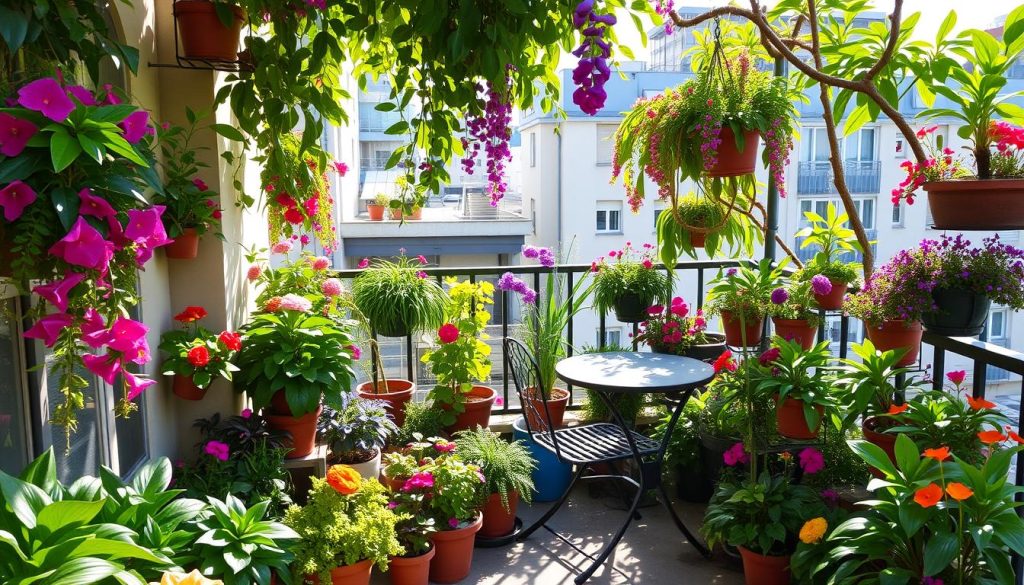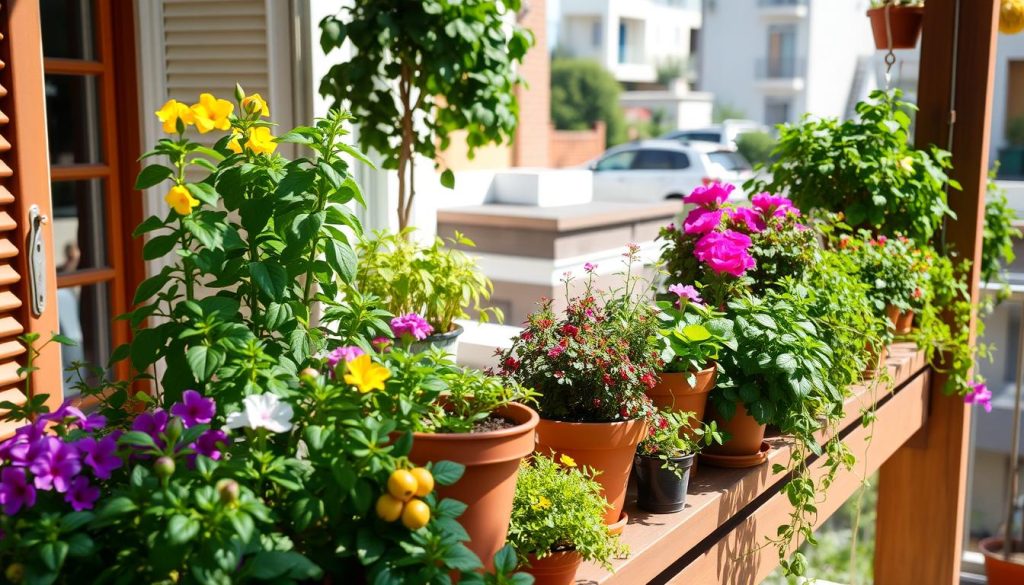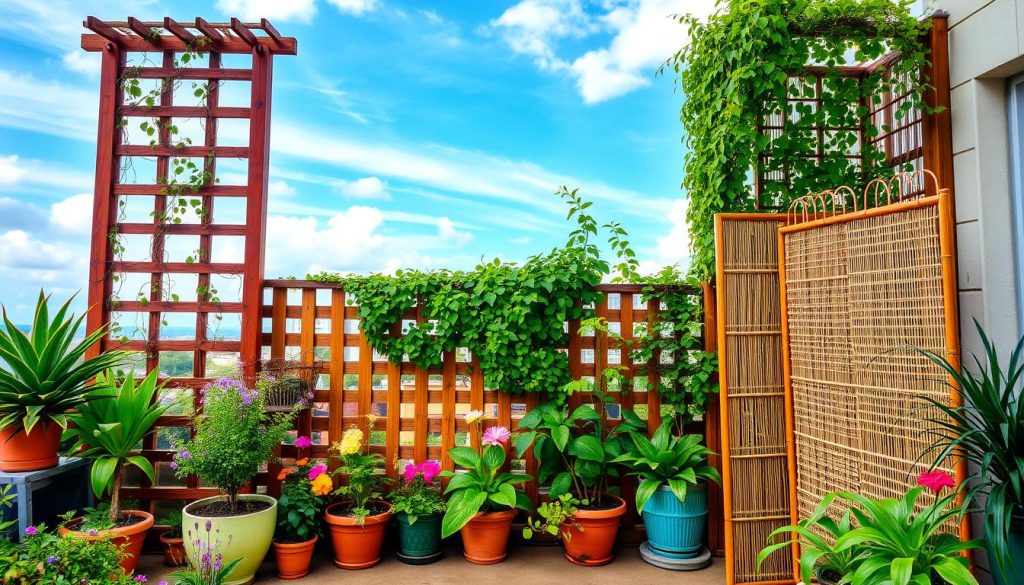Balcony gardening turns small urban areas into lush green spaces. It’s perfect for both new and experienced gardeners. You can grow everything from veggies and herbs to flowers and small trees. With a little creativity and planning, you can make the most of your balcony or terrace.
Vertical gardening is a big help in balcony gardening. It lets you grow plants up walls, railings, and overhead. This saves space and makes your outdoor area more interesting. Choosing the right plants and design can make your balcony look bigger and more open.

Key Takeaways
- Balcony gardening turns small spaces into lush green areas.
- Vertical gardening saves space and adds interest.
- Choose plants and design that match your home’s style.
- Balcony gardens can have a wide range of plants, including veggies, herbs, flowers, and small trees.
- Balcony gardens are great for relaxing and enjoying the outdoors.
Getting Started with Balcony Gardening
Want to turn your balcony into a green paradise? Start small and plan carefully. First, measure your small space gardening area. Check the sunlight and any weight limits. This will guide you in choosing the best urban gardening and container gardening options.
Understanding Your Space Limitations
It’s important to know your balcony’s size and layout. Think about the sunlight it gets and any blocks to space. A sunlight calculator can show the best spot for your container gardening.
Basic Tools and Materials Needed
- Lightweight, durable containers in various sizes
- High-quality potting mix designed for container gardening
- Hand trowel, pruning shears, and a watering can
- Trays or saucers to catch excess water
Initial Planning Considerations
Before planting, plan your small space gardening layout. Think about the sun, wind, and how easy it is to get to your balcony. This helps pick the right plants and makes your urban gardening space look good and work well.
Assessing Your Balcony’s Environment
Creating a thriving balcony garden starts with knowing your microclimate. First, check how much sun exposure your balcony gets. Think about how nearby buildings, trees, or structures affect the light and wind protection.
Notice how the temperature changes and if your balcony gets too hot. This is especially true for concrete or other materials that hold heat. Find the shaded spots that might get too hot or dry. This helps you pick the right plants and set up good microclimates.
For example, south-facing balconies get lots of sunlight. They’re great for plants like lavender, geraniums, and succulents. North-facing balconies, with less sunlight, are better for plants that like shade, like ferns, hostas, and ivy.
Windy spots can dry out plants fast. Use wind protection like bamboo screens or planters to help. This makes your balcony garden more comfortable for your plants.
Knowing your balcony’s microclimate lets you choose the best plants. It also helps you use sun exposure and wind protection wisely. This way, your balcony garden will grow well all year round.
Weight Restrictions and Safety Considerations
When you garden on your balcony, remember the importance of weight and safety. Many buildings have rules about how much weight a balcony can hold. This is because of the heavy containers filled with soil. It’s key to follow these safety guidelines and plan well.
Maximum Load Capacity
Find out how much weight your balcony can handle. Talk to your building management or a structural engineer. They can help you pick light containers, like plastic or fiberglass, to stay within the limit.
Building Regulations and Permissions
Check the building rules before you start changing your balcony. Make sure you get permission from your building’s management. This ensures your changes meet safety standards and don’t harm the balcony’s structure.
Structural Support Requirements
Make sure your balcony can hold the weight of your garden. You might need extra support, like brackets or reinforced flooring. If you’re unsure, talk to a professional about your balcony’s strength.
Selecting the Right Containers
Container gardening is a hit with city folks and those short on outdoor space. When picking out containers for your balcony garden, think about a few key things. Look for pots and planters that are tough, light, and let water drain well.
Fabric grow bags are a top pick for container gardening. They breathe, are easy to clean, and let roots grow better than plastic pots. Self-watering planters are also great. They have built-in water tanks to keep soil moist and cut down on watering.
- Think about the container’s weight, especially if your balcony can’t handle much. Light options like recycled plastic or fiberglass work well.
- Make sure your containers have lots of holes for water to drain. This stops water from pooling and helps plants grow strong.
- Choose a container that fits your plant’s needs. Consider how deep the roots will grow and how big the plant might get.
To use your balcony space wisely, try vertical gardening. Tiered planters and hanging baskets are perfect. They let you grow many plants in a small area.
The right containers are key to a great balcony garden. Pick ones that are strong, let water drain, and fit your plants well. This way, you can create a lush spot that’s full of life and color.
Soil Selection and Preparation
Choosing the right Potting Soil is key for a thriving balcony garden. Don’t use regular garden soil in containers. It can get too dense and block water and air from reaching the roots. Instead, pick a high-quality Potting Soil or Container Mix made for container gardens.
Best Potting Mix Components
A good Potting Soil or Container Mix should have ingredients that help with drainage, aeration, and keeping nutrients. Look for mixes with:
- Peat moss or coconut coir: These help keep moisture and improve soil structure.
- Perlite or vermiculite: These add air and help water drain well.
- Compost or aged manure: These give plants the nutrients they need to grow.
Drainage Solutions
To make sure your container garden drains well, add a layer of gravel, river rocks, or broken pottery at the bottom. This layer helps prevent water from pooling and lets excess water drain out.
Soil Maintenance Tips
Keep an eye on how wet or dry your container Potting Soil is and adjust your watering. Over time, the soil can get compacted or lose nutrients. It’s important to add more Potting Soil or a slow-release fertilizer. Also, rotate your containers to get even sunlight and growth.
Choosing Plants for Your Space
Choosing the right Balcony Plants is key to a thriving balcony garden. The amount of sunlight, wind, and temperature matter a lot. Strong winds can dry out soil and harm plants, so pick ones that can handle it.
For windy spots, use lightweight containers like plastic or fiberglass. These are better than heavy terracotta or ceramic pots. In hot, windy areas, plants might need water every day. Self-watering pots and lightweight watering cans are great for easy watering.
In cold climates, choose hardy Container Vegetables and Urban Herbs. These can stand up to the weather or move indoors when it gets cold. You can grow a variety of plants, from herbs and veggies to small trees and succulents.
Plants can grow fast, so plan and maintain your garden well. With the right plants for your balcony, you can make a beautiful oasis in the city.

Vertical Gardening Solutions
Make the most of your balcony with creative vertical gardening. You can turn it into a lush, efficient garden. It will add beauty and function to your outdoor space.
Wall-Mounted Systems
Turn blank walls into living walls with modular planters. These systems let you grow different plants, like vines and flowers, without using floor space. You can find easy-to-use planters or make your own with items like old pallets or window frames.
Hanging Gardens
Hang your plants from the ceiling or balcony railings with hanging baskets or macrame holders. This method saves floor space and adds charm to your vertical gardening setup. Use plants that trail, like ivy or vines, for a lush look.
Space-Saving Techniques
- Use tiered plant stands or old ladders for vertical displays.
- Grow climbing plants on railings or custom trellises.
- Put pocket planters or fabric grow bags in corners.
- Install multi-level shelves for different plants.
Vertical gardening can turn your balcony into a green oasis. Try wall systems, hanging gardens, and space-saving ideas. This way, you can create a beautiful and thriving vertical gardening display.
Watering Systems and Management
Watering your balcony garden right is crucial for its health. Using drip irrigation or self-watering pots can save a lot of water. Check the soil moisture with a moisture meter to know when to water.
Group plants by their water needs to make watering easier. Use rainwater or air conditioning condensate to help with water. Water deeply but not too often to help plants grow strong roots.
- Use drip irrigation systems for efficient water delivery directly to the soil and roots, minimizing evaporation.
- Explore self-watering containers that have a built-in reservoir to provide consistent moisture for your plants.
- Apply a layer of mulch around your plants to retain soil moisture and reduce evaporation.
Change your watering schedule with the weather, plant growth, and soil type. Sandy soils need more water than loamy soils. Keep your irrigation system in good shape to avoid leaks and keep plants healthy.
Light Requirements and Sun Exposure
Balcony gardening needs you to know your space’s Sun Exposure well. It’s important to map the sun patterns during the day and seasons. This helps pick the right plants and manage their light needs.
Whether your balcony is south, north, east, or west, the sun’s strength and time vary a lot.
Managing Direct Sunlight
Sun-loving plants need 6 or more hours of direct sunlight a day. But, too much sun in the afternoon can burn their leaves. To fix this, put sun-loving plants at the balcony’s edges for more light.
Using light-colored containers can also spread light around.
Shade Solutions
Shade Plants need less than 3 hours of direct sunlight. Use shade cloth or umbrellas to shield them from strong sun. Trellises or screens can make dappled shade, perfect for plants needing indirect light.
Rotating your containers regularly makes sure all plants get the right Sun Exposure.
Knowing your balcony’s Sun Exposure and using creative Shade Solutions can make a great garden. With some planning and light management, your balcony garden will thrive, no matter its direction.
Seasonal Plant Care
To keep your balcony garden healthy, you need to change how you care for it with the seasons. When Winter Gardening turns to Summer Plant Care, it’s key to keep up with Seasonal Maintenance. This way, your plants will keep growing well.
In the cold months, shield your plants from frost by covering them or bringing sensitive ones inside. When it gets warmer, water your plants more often to keep them from drying out. Regular pruning and deadheading help your plants grow strong and keep blooming all season.
- Use fertilizers that match the season to meet your plants’ needs.
- In the fall, cut back on watering and fertilizing to help plants prepare for sleep.
- Think about switching plants around to keep your balcony garden interesting all year.
By paying attention to what your plants need as the seasons change, your balcony garden will flourish. With a bit of extra effort, your outdoor space will be beautiful all year.
Growing Edibles on Your Balcony
Turn your balcony into a lush urban garden. Grow Container Vegetables, Urban Herbs, and Balcony Fruits. Enjoy the taste of fresh produce from your own space.
Herbs and Vegetables
Begin with herbs and small veggies. Mint, basil, and rosemary add flavor to your dishes. For veggies, try bush beans, dwarf peppers, and small tomatoes. They fit well in pots.
- Leafy greens like spinach, kale, and Swiss chard need 12- to 18-inch deep containers.
- Use vertical space for vining plants like pole beans and cucumbers.
- Don’t plant plants from the same family in the same pot.
Fruit-Bearing Plants
Add dwarf fruit trees and berry plants to your garden. Dwarf citrus trees add beauty and taste. Try compact fig trees or strawberry vines for sweetness.
- Broccoli, cabbage, and cauliflower need a 16-inch diameter pot.
- Leafy greens like kale, chard, and collards do well in a 5-gallon pot with a 12-inch diameter.
- Plant herbs with veggies for better growth.
Choose and arrange your Container Vegetables, Urban Herbs, and Balcony Fruits wisely. Turn your small space into a lush, productive garden. Enjoy the fresh flavors from your balcony.
Wind Protection and Climate Control
Balcony gardening comes with its own set of challenges. Windbreaks are key to creating a safe space for your plants. You can use trellises, lattice panels, or tall plants to block the wind. Grouping plants together also helps protect the more delicate ones.
For quick wind protection, fabric screens or clear plastic sheets work well. Place your containers against walls or in corners to reduce wind. It’s important to watch the wind patterns and adjust your plants’ positions to keep a good microclimate.
Climate control is also vital for balcony gardeners. Cold frames or mini greenhouses can protect plants from frost or heat. Taking the right steps to protect your plants can help them grow longer and stay healthy.

Being creative and paying attention to your balcony’s microclimate can make a big difference. It can turn your balcony into a thriving, protected, and climate-controlled space.
Pest Management in Container Gardens
Keeping a container garden healthy is rewarding but comes with challenges. Common pests are a big issue. Using Organic Pest Control and integrated pest management (IPM) is crucial for a thriving balcony garden.
Common Balcony Garden Pests
Container gardens attract many pests, like aphids, spider mites, and whiteflies. Fungus gnats and larger pests like caterpillars and beetles are also a problem. These pests can harm your plants, slowing their growth and reducing yields. It’s important to spot and deal with these pests early to prevent bigger problems.
Natural Pest Control Methods
- Encourage beneficial insects: Attract predatory insects like ladybugs, lacewings, and hoverflies that feed on common garden pests.
- Use neem oil or insecticidal soaps: These organic products can effectively control a wide range of Organic Pest Control without harming your plants.
- Practice companion planting: Certain herbs and flowers can help deter pests naturally and create a balanced ecosystem in your container garden.
- Regularly inspect and remove affected plant parts: Catching and addressing issues early can prevent the spread of pests.
- Utilize physical barriers: Row covers, netting, or sticky traps can help protect your plants from unwanted guests.
- Maintain plant health: Healthy, vigorous plants are more resistant to Organic Pest Control infestations.
By using these Integrated Pest Management techniques, you can manage pests in your container garden. Enjoy a bountiful harvest. Regular monitoring, a diverse planting strategy, and targeted organic solutions are key to a thriving balcony garden.
Fertilization and Nutrition
Successful balcony gardening needs careful thought on fertilization and nutrient management. Container plant Fertilizers, Organic Nutrients, and Soil Amendments are key for your potted plants to thrive.
Begin with balanced, slow-release fertilizers made for container plants. These give nutrients steadily, so you don’t need to feed them often. Use liquid fertilizers during the growing season to give your plants a boost.
Adding organic matter like compost or worm castings to your potting mix helps a lot. These soil amendments improve soil structure and release nutrients slowly. They support plant health and growth.
- Apply water-soluble (liquid) fertilizer as plants grow to provide a quick nutrient boost.
- Opt for an equal ratio of nitrogen, phosphorus, and potassium (“N-P-K”) for balanced nutrition.
- Fruiting crops like tomatoes and peppers may benefit from a fertilizer with a higher phosphorus content to promote flowering and fruit production.
- Consider using organic options, such as fish meal emulsion or liquid kelp, for a more natural approach.
Adjust your fertilization plan based on your plants’ growth stages and needs. Watch them for signs of nutrient deficiencies. Make changes as needed to ensure they grow well.
By using the right Container Plant Fertilizers, Organic Nutrients, and Soil Amendments, you can make your balcony garden thrive. Enjoy a lush oasis and plenty of harvests, whether it’s flowers, herbs, or vegetables.
Design Tips for Beautiful Balcony Gardens
To make your balcony garden look good and work well, start with a plan. Pick a color scheme or theme to tie everything together. Mix up the plant sizes, textures, and leaves to make it interesting.
Add things like garden art, lights, or a small water feature to make it feel cozy. This will make your balcony a special place.
Choose furniture that can be both a seat and a planter. This makes your space useful and pretty. Set up different areas for relaxing and gardening. This way, your balcony will feel open and welcoming.
Think about the view from inside and outside your balcony. Place plants and decorations to make the view better. This will make your balcony a highlight of your home.
Grouping containers can make your balcony look amazing. It can also help divide the space into different areas. Don’t be afraid to change things up as your plants grow and your needs change. With a little planning and creativity, your balcony can become a beautiful oasis.